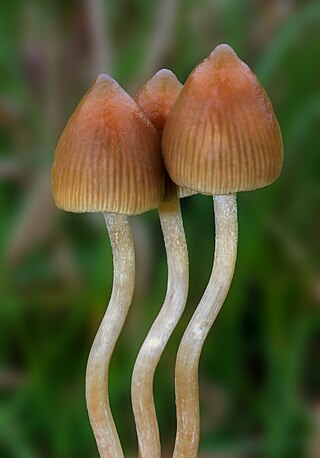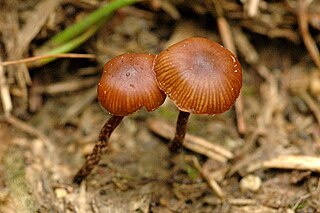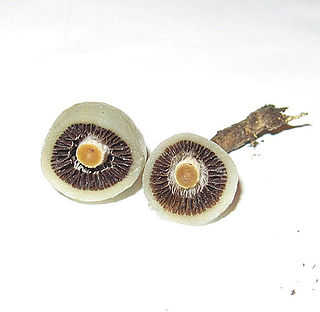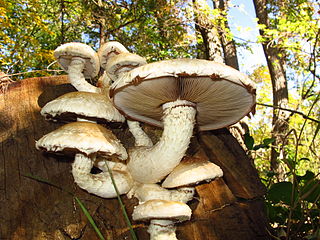
Psilocybe is a genus of gilled mushrooms, growing worldwide, in the family Hymenogastraceae. Most or nearly all species contain the psychedelic compounds psilocybin and psilocin.

Psilocybe semilanceata, commonly known as the liberty cap, is a species of fungus which produces the psychoactive compounds psilocybin, psilocin and baeocystin. It is both one of the most widely distributed psilocybin mushrooms in nature, and one of the most potent. The mushrooms have a distinctive conical to bell-shaped cap, up to 2.5 cm (1 in) in diameter, with a small nipple-like protrusion on the top. They are yellow to brown, covered with radial grooves when moist, and fade to a lighter color as they mature. Their stipes tend to be slender and long, and the same color or slightly lighter than the cap. The gill attachment to the stipe is adnexed, and they are initially cream-colored before tinting purple to black as the spores mature. The spores are dark purplish-brown in mass, ellipsoid in shape, and measure 10.5–15 by 6.5–8.5 micrometres.

The Strophariaceae are a family of fungi in the order Agaricales. Under an older classification, the family covered 18 genera and 1316 species. The species of Strophariaceae have red-brown to dark brown spore prints, while the spores themselves are smooth and have an apical germ pore. These agarics are also characterized by having a cutis-type pileipellis. Ecologically, all species in this group are saprotrophs, growing on various kinds of decaying organic matter. The family was circumscribed in 1946 by mycologists Rolf Singer and Alexander H. Smith.

Deconica inquilina is a species of mushroom in the family Strophariaceae. Formerly a member of the genus Psilocybe, this species belonged to the non-blueing (non-hallucinogenic) clade and was consequently moved to Deconica in 2009.

The Hymenogastraceae is a family of fungi in the order Agaricales with both agaric and false-truffle shaped fruitbodies. Formerly, prior to molecular analyses, the family was restricted to the false-truffle genera. The mushroom genus Psilocybe in the Hymenogastraceae is now restricted to the hallucinogenic species while nonhallucinogenic former species are largely in the genus Deconica classified in the Strophariaceae.

Deconica montana, commonly known as the mountain moss Psilocybe, is a common species of mushroom that usually grows in mossy and montane regions around the world. The appearance is that of a typical "little brown mushroom" with a small, brown cap and a straight, thin stipe.

Weraroa was a genus of mushrooms from the families Hymenogastraceae and Strophariaceae. The genus was initially described by mycologist Rolf Singer in 1958 to accommodate the single species Secotium novae-zelandiae reported by Gordon Herriott Cunningham in 1924. It was thought that the genus represented an intermediary evolutionary stage between a hypogeous (underground) ancestor and the related epigeous genus Stropharia. Advances in phylogenetics and taxonomic changes since 1958 found it contained unrelated species from multiple genera. It is now considered a synonym of the genus Psilocybe.

Psilocybe weraroa is a secotioid fungus in the family Hymenogastraceae. It is endemic to New Zealand, where it grows in native forests from rotting wood and woody debris. Despite its pouch-like form this species is closely related to Psilocybe cyanescens and Psilocybe subaeruginosa. As a bluing member of the genus Psilocybe it contains the psychoactive compounds psilocin and psilocybin.
Psilocybe acutipilea is a species of mushroom-forming fungus in the family Hymenogastraceae. It was discovered in October 1881 in Apiahy, Sao Paulo State, Brazil by Carlos Spegazzini, and described by him as a new species of Deconica in 1889. Gastón Guzmán transferred it to Psilocybe in 1978, but Ramirez-Cruz considered it a possible synonym of Psilocybe mexicana, but the type specimen was too moldy for them to be certain.

Deconica coprophila, commonly known as the dung-loving psilocybe, or dung demon, is a species of mushroom in the family Strophariaceae. First described as Agaricus coprophilus by Jean Baptiste François Pierre Bulliard in 1793, it was transferred to the genus Psilocybe by Paul Kummer in 1871. In the first decade of the 2000s, several molecular studies showed that the Psilocybe was polyphyletic, and the non-bluing (non-hallucinogenic) species were transferred to Deconica.

Hemipholiota is a genus of agaric fungi in the order Agaricales. It was originally proposed by Rolf Singer in 1962 as a subgenus of Pholiota to contain species with absent or sparse pleurocystidia and absent chrysocystidia. Henri Romagnesi raised it to generic status in 1980, but this naming was invalid as it did not meet the requirements of the International Code of Nomenclature for algae, fungi, and plants. Marcel Bon published the genus validly in 1986.
Deconica neorhombispora is a species of agaric fungus in the family Strophariaceae. It can be found in Brazil and Mexico. It was originally described from specimens found near San Bartolomé Ayautla, Oaxaca, Mexico as Naematoloma rhombisporum, then transferred to Hypholoma rhombispora. After this, it was transferred to Psilocybe neorhombispora because the name "Psilocybe rhombispora" was already occupied, but this species is now a synonym of Deconica phyllogena. Psilocybe neorhombispora was finally transferred to Deconica neorhombispora. Psilocybe subbrunneocystidiata was originally named as a new species of Psilocybe from Itapuã State Park in Rio Grande do Sul, Brazil. The authors assigned it to Psilocybe section brunneocystidiatae with Psilocybe brunneocystidiata, Psilocybe neocaledonica and Psilocybe aureicystidiata. Psilocybe subbrunneocystidiata was found to be a synonym of Deconica neorhombispora. Psilocybe neocaledonica and Psilocybe aureicystidiata were also found to belong in Deconica.
Deconica alpestris is a species of mushroom in the family Strophariaceae. Its holotype was found by Rolf Singer in 1979 growing on calcareous soil at an elevation of 1900 meters in the alps in Austria.
Deconica pegleriana is a species of mushroom in the family Strophariaceae. It can be found in Mexico, Thailand, India, Papua New Guinea, the Southeastern United States and South America.
Deconica semiinconspicua is a mushroom native to the state of Washington in the United States. The mushroom is small, rare, difficult to see and, according to Guzmán and Trappe (2005), stains blue where damaged. However, Ramírez-Cruz et al. (2012) state that it is "without a really observable bluing reaction". It was described as a psychoactive species of Psilocybe in section Semilanceatae, but Ramírez-Cruz et al. (2012) found that its macroscopic and microscopic morphological features and its DNA sequence, which Ramírez-Cruz et al. did not publish, were a better match for Deconica. Ramírez-Cruz et al. (2012) also stated that it is very similar to Deconica montana. It can be mistaken for Psilocybe silvatica and can be distinguished by its more conic cap, narrower spores and narrower cheilocystidia.
Deconica thailandensis is a species of mushroom in the family Strophariaceae. It is found in Thailand.
Deconica pseudobullacea is a species of mushroom in the family Strophariaceae.
Deconica goniospora is a species of mushroom in the family Strophariaceae. It is found in Sri Lanka.
Deconica neocaledonica is a species of mushroom in the family Strophariaceae. It has been found in New Caledonia and in Mount Halimun Salak National Park in Java, Indonesia. It is very similar to Deconica aureicystidiata.










